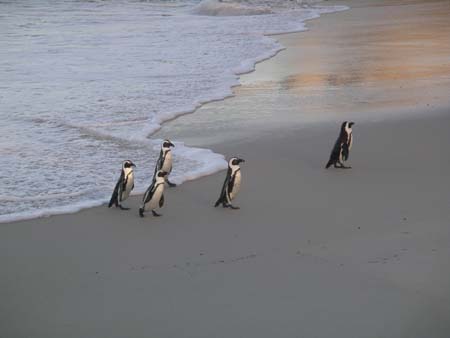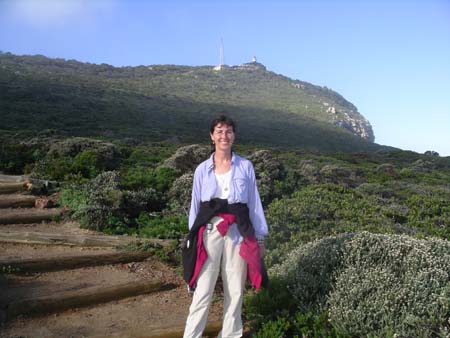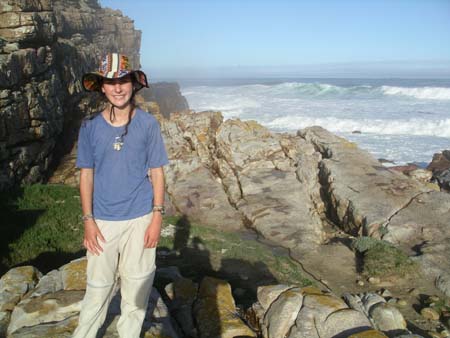Wednesday, June 16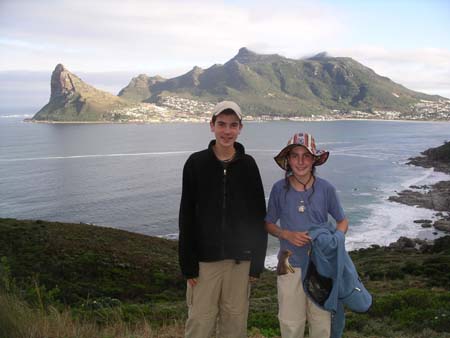
Steve: We had been waiting for a sunny day to make the drive down the Cape Peninsula to Cape Point. This is winter here in South Africa, and Cape Town is known for its cool, cloudy and often rainy weather during this season. By our standards, winter here is extremely mild (as evidenced by the palm trees that grow), and even the last couple of cloudy days were very comfortable, with temperatures in the 60's. This morning we woke up to bright skies, warm air and a promising forecast, so we set off.
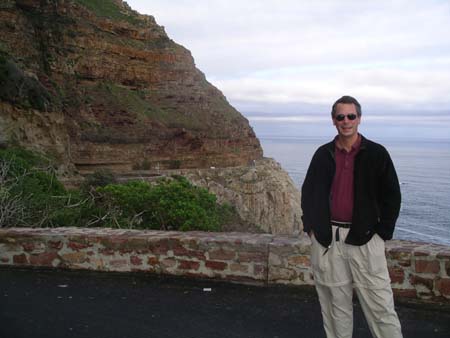 The
drive along the Cape Peninsula is really beautiful (or "stunning",
as people here say). Part of the road is brand new, and has been cut impressively
right into the cliffs. Our first stop was at a viewpoint looking back toward
Hout Bay where we had visited earlier in the week. From
The
drive along the Cape Peninsula is really beautiful (or "stunning",
as people here say). Part of the road is brand new, and has been cut impressively
right into the cliffs. Our first stop was at a viewpoint looking back toward
Hout Bay where we had visited earlier in the week. From 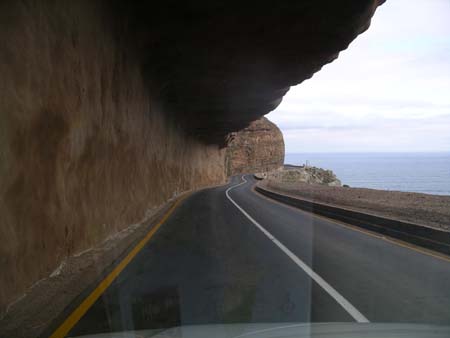 there
we continued driving down toward Chapman's Peak where we looked down to the
swirling seas hundreds of feet below. The beach at Noordhoek is very impressive
- it may be the largest beach we have ever seen (at least all at once).
there
we continued driving down toward Chapman's Peak where we looked down to the
swirling seas hundreds of feet below. The beach at Noordhoek is very impressive
- it may be the largest beach we have ever seen (at least all at once). 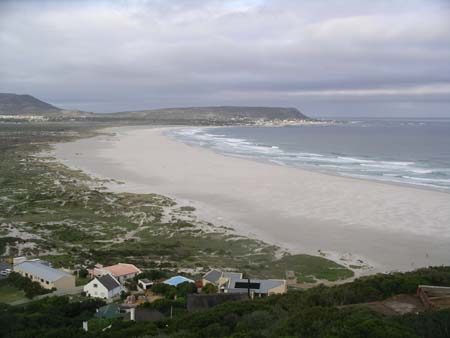 It's
very wide and stretches over four miles. The waters are too dangerous to swim,
but many people ride horses along the shore.
It's
very wide and stretches over four miles. The waters are too dangerous to swim,
but many people ride horses along the shore.
As we drove further south, the skies became increasingly cloudy and eventually
we found ourselves in a thick fog. We decided to stop at Platboom Bay, a beach
with huge crashing waves. We all enjoyed 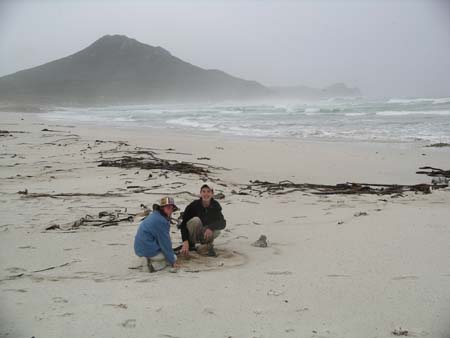 hanging
out at the beach, admiring the sea and playing in the sand. Our hope was that
the weathe
hanging
out at the beach, admiring the sea and playing in the sand. Our hope was that
the weathe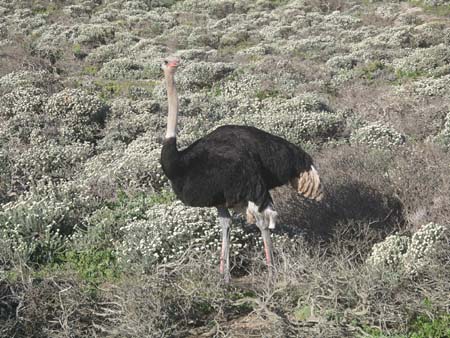 r
would clear, but it actually kept getting worse until we were forced back
into the cars by a light drizzle.
r
would clear, but it actually kept getting worse until we were forced back
into the cars by a light drizzle.
The landscape of the peninsula reflects the harsh weather conditions that
often occur here. The flora consists primarily of low shrubs that become green
and flower now during the wet season. There is also a good variety of natural
wildlife, including a variety of antelope, baboons and ostriches. Today we
saw some of the antelope, and also several ostriches.
We drove the rest of the way to Cape Point in the fog, disappointed and somewhat frustrated that we had made the drive but were unable to see any of our surroundings. When we arrived at the main visitor area, the fog was so thick that we couldn't even see the water - so we decided to eat lunch and see what happened…
As we were finishing lunch, the skies suddenly began to brighten, and by
the time we were done we were standing under blue skies! Soon we could see
the outline of the peninsula, and the lighthouse sitting above at the top
of Cape Point. It didn't take long for the air to clear enough for us to see
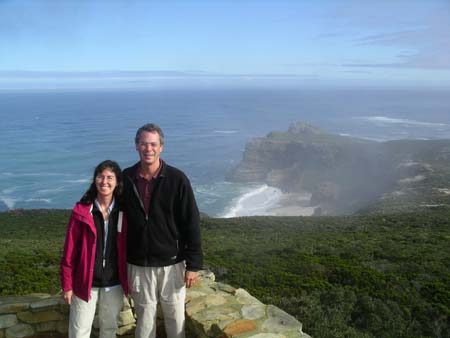 the
swirling water and huge swells below. Cape Peninsula is a notoriously dangerous
area for ships, and hundreds of wrecks have been recorded here over the years.
Some of these are actually still visible.
the
swirling water and huge swells below. Cape Peninsula is a notoriously dangerous
area for ships, and hundreds of wrecks have been recorded here over the years.
Some of these are actually still visible.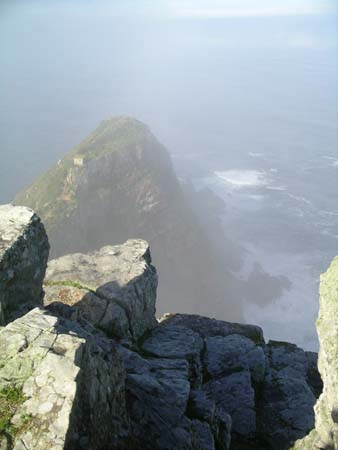
We walked up to the lighthouse, from where we had nice views looking back
along the peninsula and also to the rocks at the southern tip. Although the
skies were now blue, the fog kept rolling in and out, so we had to 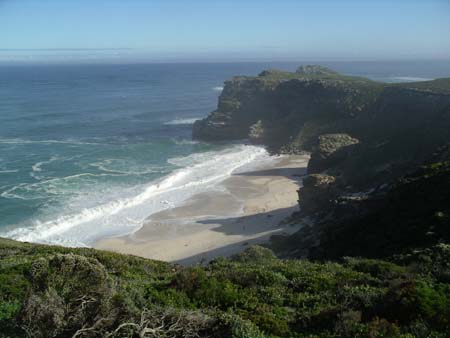 take
pictures when we could… We also hiked along a trail leading from the
visitor's area toward a cliff high above another sandy beach. As we walked,
Paula (screaming excitedly) spotted a whale just off the shore, and we all
watched as he breached repeatedly, making huge splashes as he hit the water.
This area is famous for its whales, with the most common being the southern
right whale. The whales generally start arriving in June, and stay through
November.
take
pictures when we could… We also hiked along a trail leading from the
visitor's area toward a cliff high above another sandy beach. As we walked,
Paula (screaming excitedly) spotted a whale just off the shore, and we all
watched as he breached repeatedly, making huge splashes as he hit the water.
This area is famous for its whales, with the most common being the southern
right whale. The whales generally start arriving in June, and stay through
November.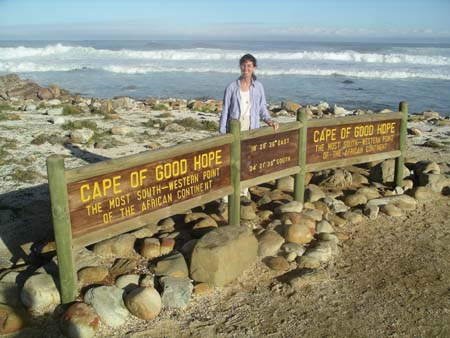
On our way back, we stopped briefly at the Cape of Good Hope to take pictures and admire the waves. These were probably the biggest swells that we saw today, and as we watched the sea it was easy to understand why this area is so hazardous to ships.
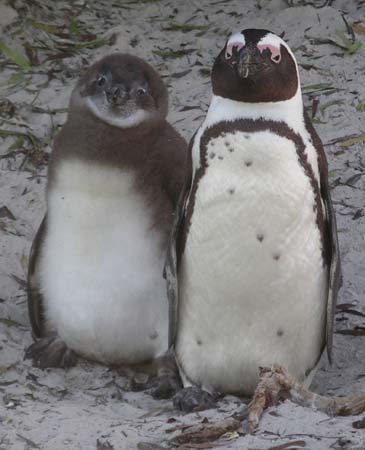 During
our drive back toward Cape Town, we stopped at Boulder's Beach near Simon's
Town. This is the home to a colony of 3,000 African penguins. These are the
only penguins that breed naturally in Africa, and were once considered an
endangered species (they're now classified as "vulnerable"). The
approach to the colony is along a boardwalk that's lined with nesting
During
our drive back toward Cape Town, we stopped at Boulder's Beach near Simon's
Town. This is the home to a colony of 3,000 African penguins. These are the
only penguins that breed naturally in Africa, and were once considered an
endangered species (they're now classified as "vulnerable"). The
approach to the colony is along a boardwalk that's lined with nesting 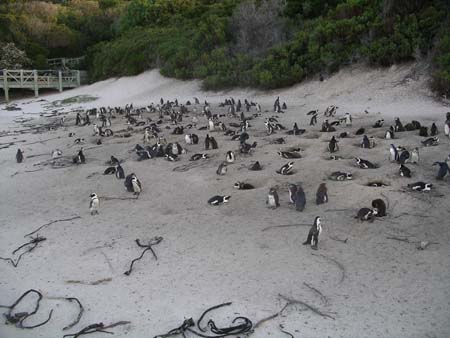 penguins.
Several of these had their nests right along the walk, and we saw young birds
of all ages, including some that appeared to only be a few days old. The main
part of the
penguins.
Several of these had their nests right along the walk, and we saw young birds
of all ages, including some that appeared to only be a few days old. The main
part of the 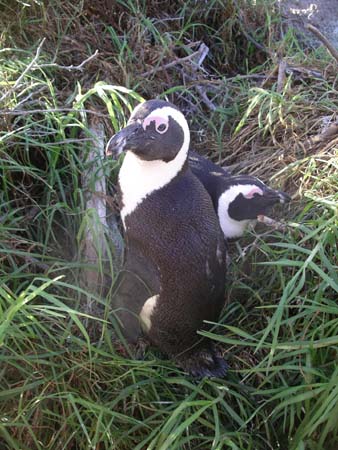 colony
lives on a small beach, and it was wonderful to see them all in one spot.
We arrived during the late afternoon at the time that the parents return from
feeding, and it was fun to see them emerge from the water, shake off, and
walk to their nests to feed their young.
colony
lives on a small beach, and it was wonderful to see them all in one spot.
We arrived during the late afternoon at the time that the parents return from
feeding, and it was fun to see them emerge from the water, shake off, and
walk to their nests to feed their young.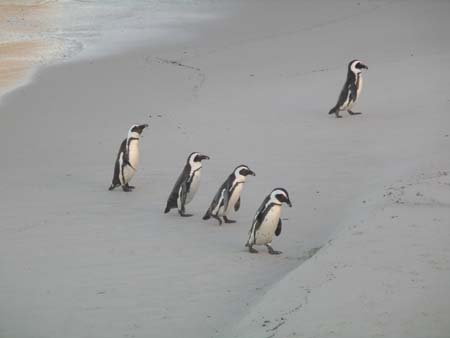
This evening we had a delightful dinner at the home of Jenny and Peter (they
are friends of a friend of a friend!). It was interesting to hear their perspective
about elements of life here in Cape Town, and we 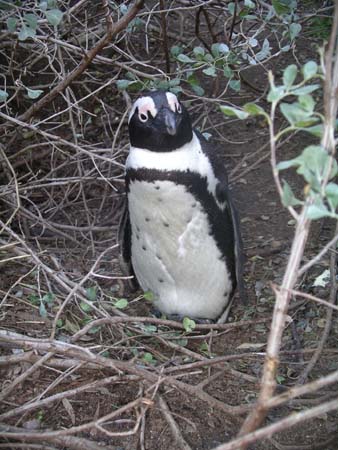 also
got some great advice for the remainder of our time in South Africa.
also
got some great advice for the remainder of our time in South Africa.
Tomorrow we hope to drive north to the Stellenbosch area, famous for its
vineyards and quaint  towns.
towns.

